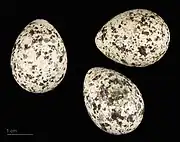Common buttonquail
The common buttonquail (Turnix sylvaticus), also called Kurrichane buttonquail, small buttonquail, or Andalusian hemipode is a buttonquail, one of a small family of birds which resemble but are not closely related to the true quails.
| Common buttonquail | |
|---|---|
 | |
| Scientific classification | |
| Domain: | Eukaryota |
| Kingdom: | Animalia |
| Phylum: | Chordata |
| Clade: | Dinosauria |
| Class: | Aves |
| Order: | Charadriiformes |
| Family: | Turnicidae |
| Genus: | Turnix |
| Species: | T. sylvaticus |
| Binomial name | |
| Turnix sylvaticus (Desfontaines, 1789) | |
| Synonyms | |
|
Turnix sylvatica | |
Taxonomy
The common buttonquail was formally described and illustrated in 1789 by the French botanist René Desfontaines under the binomial name Tetrao sylvaticus.[3] The specific epithet sylvaticus is Latin meaning "of the woods".[4] The common buttonquail is now placed in the genus Turnix that was introduced in 1840 by Pierre Bonnaterre.[5]
Nine subspecies are recognised:
- T. s. sylvaticus (Desfontaines, 1789) – south Iberian Peninsula and northwest Africa
- T. s. lepurana (Smith, A, 1836) – Africa south of the Sahara
- T. s. dussumier (Temminck, 1828) – east Iran to Myanmar
- T. s. davidi Delacour & Jabouille, 1930 – central Thailand to south China, north Indochina and Taiwan
- T. s. bartelsorum Neumann, 1929 – Java and Bali
- T. s. whiteheadi Ogilvie-Grant, 1897 – Luzon (north Philippines)
- T. s. celestinoi McGregor, 1907 – Bohol and Mindanao (south Philippines)
- T. s. nigrorum duPont, 1976 – Negros (central west Philippines)
- T. s. suluensis Mearns, 1905 – Sulu Archipelago (south Philippines)
Description
The common buttonquail resembles the common quail. It has streaked sandy brown upperparts, buff underparts with black flank markings, and a plain face. In flight, a whitish wingbar contrasts with the grey wing. Sexes are similar, but immature birds are more spotted below. This tiny buttonquail is notoriously difficult to see. It is a small, 15 cm (5.9 in) long drab running bird, which avoids flying.
Distribution and habitat
This species is resident from southern Spain and Africa through India and tropical Asia to Indonesia. It inhabits warm grasslands or scrub jungle and feeds on insects and seeds. This species avoids thick forest and hilly country, and lives by preference in cornfields and stretches of grassy plain though it may also be found in any type of low herbage and open scrub jungle.
Behaviour
It skulks and is flushed with difficulty, rising often close by one's feet. When flushed it flies low over the ground and soon settles again, after which it is very difficult to put up a second time. The female calls with a deep hoom-hoom-hoom and the male replies kek-kek-kek.
Breeding

The female initiates courtship and builds the ground nest. The male incubates the normally four speckled greyish eggs, and tends the young, which can run as soon as they are hatched. The nesting season is June to September. The nest is a slight pad of grass placed in a natural hollow in the ground where it is usually tucked away amongst the stems of a tuft of grass. Very occasionally the grass is bent over it in a sort of canopy.[6]
Conservation
Widespread throughout its large range, the small buttonquail is evaluated as least concern on the IUCN Red List of Threatened Species.[1] However, the nominate subspecies which is distributed in the Mediterranean region is critically endangered. It disappeared from most of its range during the 20th century and is currently only present in Morocco after Spain officially declared the extinction of the species in 2018.[7][8][9] In 2021, the IUCN also declared the buttonquail extinct in Europe.[1] This makes it the first bird species to have become extinct in Europe since the Great Auk in 1852.
Gallery
._Maharashtra%252C_India.jpg.webp) Maharashtra, India
Maharashtra, India Painting by John Gould
Painting by John Gould South Africa, Kruger National Park
South Africa, Kruger National Park South Africa, Ithala Game Reserve
South Africa, Ithala Game Reserve
References
- BirdLife International (2016). "Turnix sylvaticus". IUCN Red List of Threatened Species. 2016: e.T22680500A90008182. doi:10.2305/IUCN.UK.2016-3.RLTS.T22680500A90008182.en. Retrieved 1 November 2021.
- BirdLife International (2015). "Turnix sylvaticus Europe". IUCN Red List of Threatened Species. 2015: e.T22680500A59976610. Retrieved 1 November 2021.
- Desfontaines, René Louiche (1789). "Mémoire sur quelques nouvelles espèces d'oiseaux des côtes de Barbarie". Histoire de L'Académie Royale des Science (in French): 496-505 [500, Plate 13].
- Jobling, James A. (2010). The Helm Dictionary of Scientific Bird Names. London: Christopher Helm. p. 375. ISBN 978-1-4081-2501-4.
- Gill, Frank; Donsker, David; Rasmussen, Pamela, eds. (July 2023). "Buttonquail, thick-knees, sheathbills, plovers, oystercatchers, stilts, painted-snipes, jacanas, Plains-wanderer, seedsnipes". IOC World Bird List Version 13.2. International Ornithologists' Union. Retrieved 29 August 2023.
- Whistler, Hugh (1949). Popular Handbook of Indian Birds. London: Gurney and Jackson.
- Gutiérrez, C., Copete, J.L., Crochet, P.-A., Qninba, A. & Garrido, H. 2011. History, status and distribution of Andalusian Buttonquail in the WP.Dutch Birding 33: 75-93.
- MaghrebOrnitho, 2018. Andalusian Buttonquail legally declared extinct in Spain. MaghrebOrnitho, Published on 9 November 2018.
- Violani, C. G. & Massa, B. 1993. Extinction of the Andalusian Hemipode Turnix s. sylvatica (Desf.) in the Mediterranean region . Bull. Br. Ornithol. Cl. 113: 225-229.
- Barlow, Clive; Wacher, Tim; Disley, Tony (1997). Birds of The Gambia. ISBN 1-873403-32-1.
External links
- BirdLife species factsheet for Turnix sylvaticus
- Common buttonquail or Kurrichane buttonquail Species text in The Atlas of Southern African Birds
- "Turnix sylvaticus". Avibase.
- "Common buttonquail media". Internet Bird Collection.
- Small Button-Quail photo gallery at VIREO (Drexel University)
- Interactive range map of Turnix sylvaticus at IUCN Red List maps
- Audio recordings of Common buttonquail on Xeno-canto.

